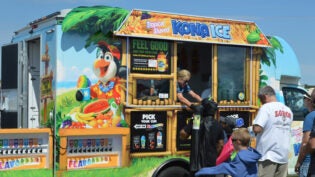Home > Startup > Franchise Center >
5 Things You Need to Know Before Investing in a Frozen Yogurt Franchise
By: Brian Bixler

Trying to get a handle on the frozen yogurt phenomenon that continues to sweep the country, nay the world, Daniel Gross, a columnist and global business editor at Newsweek Daily Beast, recently intertwined criticism and realism with his observations about the sector. He peppered his sometimes caustic prose with figures from FRANdata.
In the past five years, Gross noted, 40 new franchised frozen yogurt brands entered the market. At the end of 2012, there were 52 companies soliciting franchise partners. Combined, these companies had 2,200 franchised stores in 2012, up 69 percent from 1,300 at the end of 2008. Between 2001 and 2003, one new brand started franchising; between 2010 and 2012, 32 did.
Reasonable investment levels, low employment overhead for self-serve models, low operational costs compared with other food service businesses, and relative ease are just some of the factors that might appeal to a person looking to open a small business with support from a franchisor. But there are important things a potential operator should keep in mind before signing on the dotted line to become a frozen yogurt purveyor.
1. Catering to Customer Tastes
Neapolitan is so 1950s. Creating exotic, proprietary and, in some cases, chef-created frozen yogurt flavors and toppings is one of the keys to attracting and keeping customers. Vanilla, chocolate and strawberry don’t cut it these days when some brands offer as many as 140 flavors with names such as Apple Cider Pound Cake, Mudpie, and Red Velvet Cake.
Customer preferences seem to range from tart, fruity flavors to more decadent, chocolaty concoctions similar to ice cream. Brands that can cater to both taste types may be a wiser choice in serving the largest number of customers possible. Yogurtland has proprietary flavors and creates perhaps the most interesting flavor choices for customers. Menchie’s is also notable for its impressive variety of selections.
2. Differences in Concept
Along with the rapid expansion of frozen yogurt shops has come varying concepts. Most shops remain strip mall-based businesses where shoppers, particularly parents and their children, can stop for a quick treat in a comfortable pastel-splashed environment.
But recently brands have been developing prototypes that are more like Internet cafes and coffee shops with lounge-like interiors designed to make customers linger. One of the best examples of the latter is Let’s YO!, aimed at drawing ‘tweens, teens, and college-age consumers with an emphasis on a sleek, modern environment outfitted with the latest high-tech gadgetry.
Investors should consider what concept is best for them: a small and simple You Say When Yogurt Shoppe, where investment might be less than $100,000, or a decked out Let’s YO!, where amenities such as iPads and flat-screen monitors can push initial investment estimates to as much as $547,000.
3. Seasonal Sales
The craving for a frothy, frozen dessert is more likely to come upon a person during the blistering heat of summer when leisure time is more plentiful, and beating the heat with a cold cup of something frozen might be more refreshing than it would be in the dead of winter.
Some companies are proactive in offsetting the seasonality of sales by throwing marketing dollars at the problem. Investors should ask a company how it counters the problem of seasonal sales.
Some of them focus on limited-time offerings, introduce special promotions or capitalize on holiday offerings such as Valentine’s Day-themed products to draw in customers. Others like sweetFrog and Menchie’s have a merchandise retail area built right into the units that offers a second revenue stream. Still others, such as 16 Handles, focus on a line of other tempting confections, including frozen yogurt birthday cakes, to support year-round sales.
4. Facebook Likes
Utilizing social media in marketing plans has become essential to all businesses today and frozen yogurt shops are no exception. It’s important for building brand awareness, maintaining customer loyalty and garnering new customers. Facebook, Twitter, Instagram and Foursquare are just a few of the platforms that should be considered when promoting a new business.
Some frozen yogurt brands are using these tools more effectively than others. One of the leaders is Red Mango, a company where sometimes even CEO Dan Kim answers posts personally on social media sites. It has ranked among the top three companies on Nation’s Restaurant News’ Restaurant Social Media Index, considered to be the industry’s most comprehensive analysis of restaurant and consumer social media efforts.
At 16 Handles, CEO Solomon Choi also realizes the importance of reaching customers through social media and insists that every Tweet and Facebook posting be responded to at the corporate level in a timely manner.
5. The Saturation Factor
While the immediate future looks rosy for brands such as Pinkberry and Yogurtland, some consolidation has already occurred with relatively young startups being gobbled up by more established brands.
In the last few years, analysts have modified their forecasts for the sector, with less emphasis on market saturation and more on continued growth. The $760 million frozen yogurt sector remains one of the fastest-growing areas in franchising. IBISWorld, an independent industry and market research company, has forecast continued strength in the segment with revenue growing at average annual rates of 2.2% during the next five years.
Still, with U-Swirl having recently acquired two of its competitors, investors should be mindful of that trend continuing as they make their decision about which brand offers them the best opportunity in a market that will eventually become saturated.
Published: September 9, 2013
7223 Views
7223 Views












